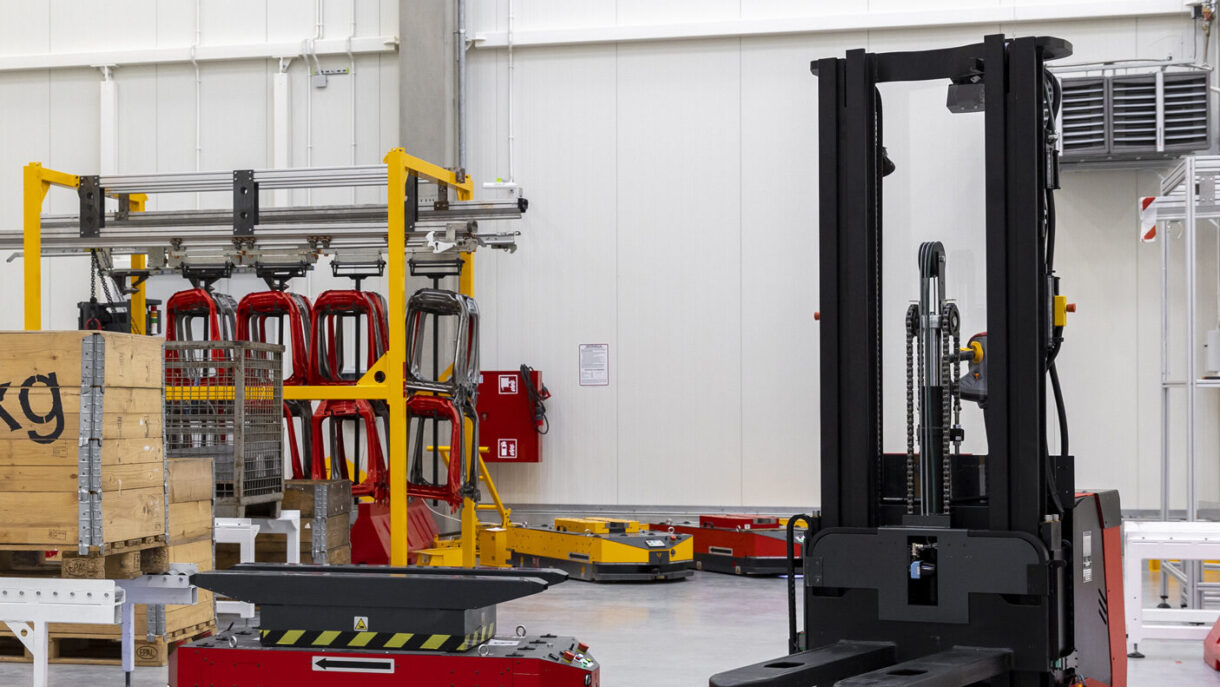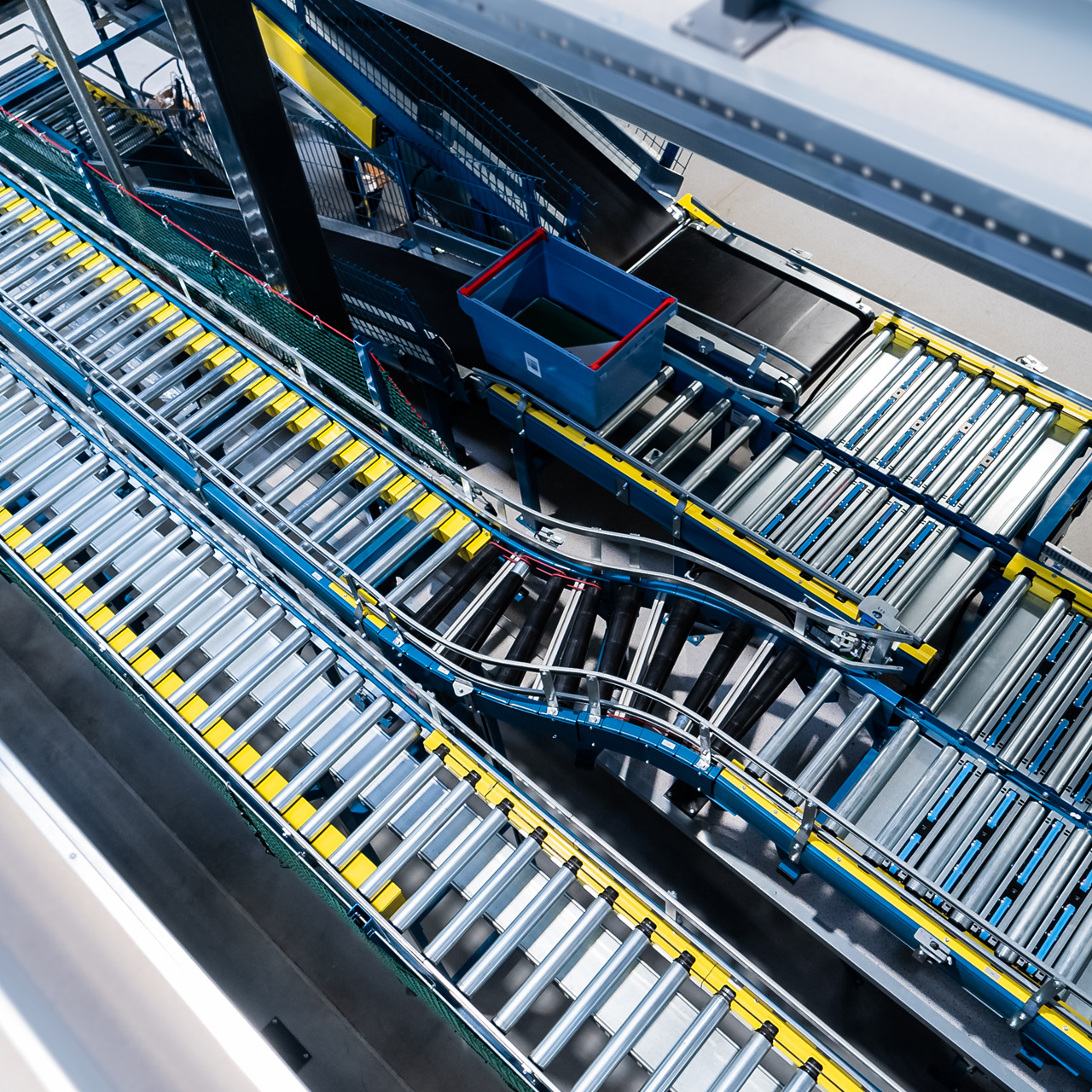Interoperability in Autonomous Intralogistics Systems

Introduction:
In today’s fast-paced business environments, the demand for speed, precision, and efficiency in logistics processes has driven the adoption of autonomous mobile robots in intralogistics systems. These robots offer a wide range of benefits by autonomously navigating warehouses, transporting pallets, sorting goods, and optimizing overall logistics operations. However, in real-world industrial environments, multiple types of mobile robots from different manufacturers are often deployed, necessitating interoperability between these devices. In this blog post, we’ll delve into the significance of interoperability in autonomous intralogistics systems and explore the role of the VDA5050 standard in enabling large-scale implementations of these solutions.
The Importance of Interoperability:
Interoperability refers to the ability of various systems, devices, or programs to collaborate and exchange information in a manner understandable to all parties involved. In the context of intralogistics systems, interoperability entails the seamless communication between autonomous mobile robots of different brands operating within the same logistics environment. Achieving this level of interoperability is crucial for maximizing the potential of these systems and ensuring smooth collaboration between robots from different manufacturers.
Moreover, the modern shop floor – be it factory or a warehouse – contains growing number of interrelated automated infrastructure systems: security and access control (automatic doors, virtual fences, fire alarms), PLC driven systems which interact with intralogistics processes (conveyor outlets/inlets), automatic shelves and racks, as well as robots and cobots which can interact with autonomous intralogistics devices. These systems execute processes which are often interdependent and require some form of integration.
The VDA5050 standard, developed by the German Association of the Automotive Industry (VDA), plays a pivotal role in ensuring interoperability and collaboration between different devices and systems in intralogistics. This standard defines uniform communication protocols, data formats, and interfaces that enable intelligent devices to work harmoniously within a single system. With the VDA5050 standard in place, mobile robots from various manufacturers can exchange information, coordinate their actions, and collaborate to accomplish complex logistics tasks.
Enabling Large-Scale Implementations with VDA5050:
Large-scale implementations of intralogistics solutions based on autonomous mobile robots often require the integration of different systems and devices sourced from multiple manufacturers. The VDA5050 standard eliminates communication barriers between these diverse devices. By adopting this standard, enterprises can effectively create integrated intralogistics systems that leverage various brands and models of mobile robots without undergoing complex integration processes.
The implementation of the VDA5050 standard facilitates the exchange of information related to status, location, assigned tasks, and other relevant data among mobile robots from different manufacturers. As a result, these robots can collaborate in real-time, avoiding collisions, optimizing transport routes, and adapting to dynamic environmental conditions. This increased collaboration and seamless interoperability lead to enhanced operational efficiency and time savings in logistics processes.
VDA 5050 Challenges
While the VDA5050 standard plays a crucial role in enabling interoperability in autonomous intralogistics systems, there are still several challenges that need to be addressed during its implementation for truly autonomous devices. The focus of VDA5050 standard has been initially on management of Automated Guided Vehicles (AGVs) rather than Autonomous Mobile Robots (AMRs). This fact has been often raised in discussions about standards, and there are some notable AMR vendors which openly refuse to join the VDA5050 bandwagon, despite efforts to make the standard more AMR friendly (eg – by adding some flexibility related to optional parameters or providing ways to allow for freedom of navigation by specifying the path divergence tolerance). Fact remains, that AGVs and AMRs are both types of autonomous mobile robots used in intralogistics, but they differ fundamentally in some of their capabilities and characteristics. So, there is a natural difficulty in defining a consistent and unambiguous standard that fits both.
AGVs are typically guided by predefined paths, tracks, or markers and are commonly used in manufacturing and warehouse environments for material handling and transportation tasks. On the other hand, AMRs are more versatile and flexible in their navigation capabilities. They use advanced sensing technologies such as lidar, cameras, or SLAM (Simultaneous Localization and Mapping) to navigate autonomously in dynamic environments without the need for predefined paths or tracks.
While the VDA5050 standard is still relevant for many aspects of interoperability in AMR deployments, considerations and adaptations required to fully address the unique navigation and operational characteristics of AMRs are the major aspect affecting the compatibility of AMR with VDA5050. As the field of autonomous intralogistics evolves, there may be a need for standards specifically tailored to the unique requirements and capabilities of AMRs to ensure seamless interoperability between different systems and devices. Until then, AMR vendors need to take decisions whether to develop adapters which allow for VDA5050 based process control while retaining as much of the autonomous capabilities of their devices as possible. This approach has been taken by VERSABOX who provides VDA5050 adapters for their AMRs.
Here are some other challenges:
- Standard Adoption: The adoption of the VDA5050 standard by manufacturers and stakeholders is vital for its successful implementation. However, ensuring widespread adoption and adherence to the standard across the industry can be a challenge. It requires collaboration and agreement among various manufacturers, system integrators, and solution providers to embrace the standard and implement it consistently.
- Integration Complexity: Implementing the VDA5050 standard across a diverse range of autonomous devices and systems can be complex. Integrating existing systems and legacy devices with the standard may require significant modifications or upgrades, which can be time-consuming and costly. Additionally, ensuring backward compatibility and seamless integration with different generations of devices adds another layer of complexity.
- Security and Privacy: Interoperability introduces potential security vulnerabilities and privacy concerns. When autonomous devices communicate and exchange data, it becomes crucial to establish secure channels and protocols to protect sensitive information from unauthorized access or malicious attacks. Implementing robust security measures and adhering to privacy regulations is essential to build trust and safeguard critical data.
- Scalability and Flexibility: As the number of autonomous devices in an intralogistics system increases, the scalability and flexibility of the VDA5050 standard become paramount. The standard should be designed to accommodate a growing ecosystem of devices, support various communication protocols, and adapt to future technological advancements. Ensuring that the standard remains relevant and flexible over time is crucial for long-term success.
- Interoperability Testing and Certification: To achieve seamless interoperability, thorough testing and certification processes are necessary. Establishing industry-wide testing protocols and certification programs helps validate the compliance of devices and systems with the VDA5050 standard. However, developing comprehensive testing methodologies and ensuring consistent certification processes across different manufacturers and products can be challenging.
- Maintenance and Updates: Technology is continuously evolving, and updates to the VDA5050 standard may be required to address emerging requirements and advancements. Ensuring proper maintenance and regular updates to the standard while maintaining backward compatibility can be a complex task. Timely updates and clear communication channels for new versions are necessary to keep up with evolving technology trends.
Overcoming these challenges requires collaboration among stakeholders, active participation from manufacturers and industry bodies, and a commitment to driving standardization and interoperability in autonomous intralogistics systems. By addressing these challenges, the implementation of the VDA5050 standard can pave the way for seamless communication and cooperation among truly autonomous devices, unlocking the full potential of these systems in the logistics industry.
Conclusion:
In conclusion, interoperability of intelligent devices in intralogistics systems is crucial for achieving optimal performance and efficiency. Standards such as VDA5050 play a significant role in ensuring interoperability, specifically for autonomous mobile robots.
Large-scale implementations based on this standard enable enterprises to harness the capabilities of different brands and models of mobile robots while ensuring effective communication and collaboration between them. This empowers businesses to unlock the full potential of autonomous mobile robot technology, optimize logistics processes, and achieve success in today’s competitive business landscape. By embracing interoperability standards like VDA5050, companies can future-proof their intralogistics systems and pave the way for efficient and scalable operations.
Due the real challenges related to VDA5050 this is not a straightforward game – customers need to understand these challenges to make an informed decision whether to go for standard based interoperability, sacrificing some of the autonomous capabilities and making VDA5050 compability a mandatory (and potentially choice-limiting) factor for AMR vendors and devices, or risk a vendor lock-in with specific AMR vendor who offers an end-to-end solutions for process control and devices, but does not comply to VDA5050.
Luckily, with vendors such as VERSABOX, who provide end-to-end solutions but are also providing a VDA5050 compatibility capabilities customer can take a low-risk path for their investments.

